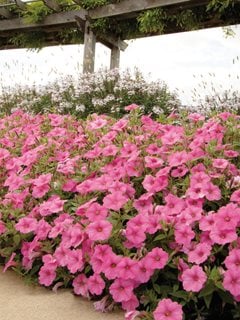Different Types of Petunia Plants
Compare the types of popular petuniasSome new petunia varieties and hybrids have become so popular, they have created a class of their own, such as the Supertunia® and Wave® series of petunias.
Supertunia®:
The Supertunia® series of petunias, part of the Proven Winners® plant line, are extremely vigorous bloomers that have the advantage of being self-cleaning, so no deadheading is needed. Flowers bloom in a broad range of colors including pastels, bright neons, and blends. Growth habits range from slightly mounded to trailing, depending on the variety. Read more about how & why to grow Supertunias.
- Supertunia® Vista petunias are fantasic landscape plants with medium-sized flowers that mound up to 24 inches and spread three to five feet. In large containers they trail up to four feet.
- Supertunia® Charm petunias are great densely-branched container plants with small flowers. They also make incredibly good landscape plants where excellent drainage is lacking.
- Supertunia® Trailing petunias are strongly trailing with medium flowers. They make good spillers in containers, hanging baskets or window boxes or can also be grown at the front of flower beds.
- Supertunia® Double petunias have large, fully doubled flowers and are good in containers or the front of garden beds.
Buy Supertunias online from Proven Winners
Spreading, or Wave® petunias:
The Wave® series of spreading petunias, introduced in 1995 by Ball Seed Co., changed the playing field for petunia lovers by giving them a fast-growing low-maintenance plant that could withstand tough weather conditions. These energetic growers, sometimes referred to as “hedgifloras,” produce blooms along the entire length of trailing stems and spread up to 4 feet or more, rapidly covering a large area of ground in one growing season. Wave® petunias are also impressive spilling over walls and fences or trailing down from hanging baskets.
Grandifloras:
One of the oldest types of petunias, Grandifloras produce large flowers (up to 5 inches wide). Although they produce fewer blooms, than other types of petunia, the huge flower size makes the grandiflora one of the showiest petunias, but also the most fragile. Grandifloras usually form large mounds of flowers 12 to 15 inches tall, but some have a cascading habit that makes them suitable for hanging baskets and window boxes. Unlike newer petunia hybrids, grandifloras also need to be deadheaded if you want them to continue blooming all summer.
Multifloras:
These petunias have smaller flowers (about 2 inches in diameter) and a more compact growth habit than grandifloras. As the name implies, they also are prolific bloomers. Although the blooms aren’t as large as those of grandifloras, they are more resilient to heat, humidity, and heavy downpours. Multifloras will also continue to flower with minimal pinching and pruning.
Floribundas:
These hybrids of grandiflora and multiflora petunias share the best qualities of both, producing grandiflora-like blooms with the vigor of a multiflora. Like the multiflora, they also tolerate poor weather conditions and require less deadheading.
Millifloras:
One of the best choices for containers, millifloras grow to only about 8 inches tall and wide and produce tiny 1-inch blooms that closely resemble those of Calibrachoa, a popular petunia look-alike.







